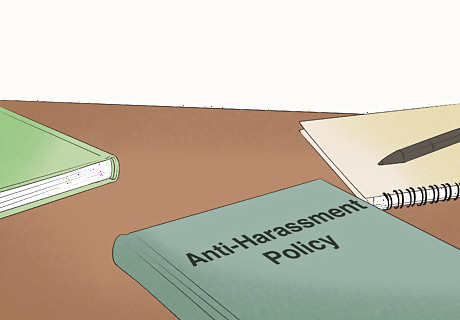
views
Handling a Racist Remark

Stay calm. Becoming visibly upset as a result of your boss’s racist words or behaviors will usually make the situation worse. If you’re the target of the racist remark, you might feel like lashing back. If you’re not the direct target, you might have a desire to defend whoever was the intended target. But if you’re looking for a way to handle the situation tactfully, you’ll need to calm down first. Take a deep breath, and count to 10 before saying anything. If you still feel like you’re unable to calm down, make an excuse and walk away from your boss if you can.

Decide to ignore the comment. If this is the first time you’ve ever heard you boss make a racist comment, it might be easiest to simply ignore it. Change the topic to a work-related concern. For example, following the offensive remark, you can simply look at your boss with a blank expression, pause, and then resume talking about the job. There’s a chance he’ll get the message that his humor or comment wasn’t appreciated without your having to say so. Try to remember that it’s not your responsibility to educate your workplace about racism. Your primary goal is to get your boss to stop making racist comments around you.

Call him out on his remark tactfully. If your boss persists in saying racist things around you, you may need to be more overt about your disapproval. You can do this tactfully, as long as you’re able to keep your cool. When your boss says the offensive thing, look at him blankly, and say something like, “Wow.” Or, even, “Wow, that was racist.” Don’t follow your statement with an explanation about how the statement was racist. Instead, redirect the conversation immediately back to a work topic. Make sure your attention is directed towards the remark rather than the person. Your boss is more likely to respond positively if told that his statement was racist than being told, “Wow, it sounds like you’re racist.”

Question why the statement was made. Asking your boss, “Why did you say that (racist thing)?” may result in his recognition that his statement was inappropriate. Or, it might reveal a misunderstanding of your own. If your boss reiterates the statement with additional racist clarification, you’ll have a better understanding of the situation. Asking your boss to explain why he made the statement also allows you time to gather your thoughts and calm yourself. If there are other people present, you’ll have more witnesses.

Ask him to repeat himself. Asking him to repeat the racist remark highlights the fact that he said it in the first place, and may make him feel ashamed without any overt accusations on your part. Repeat the process as often as you need to, so that you’re making it clear that you’re refusing to engage in racist conversation. For example, after your boss says the racist thing, pretend that you didn’t hear him. Say, “Excuse me?” If he repeats it, you can pretend not to understand. “”I’m sorry, I don’t get it.” Eventually he’ll get the message that either you’re asking him to explicitly explain his racist comment, or that he should move on in the conversation.

Write it down. Even if this is the first time you’ve ever heard your boss use a racist statement, you’ll want to keep track. Write down exactly what was said, who was present, where you were, and the time and date. Be specific. Written documentation will be required if you ever decide to take your concerns about a racist boss to your company’s human resource office or consult a lawyer. Make sure to keep your written notes in a place where others won’t find them at work.

Consider whether the comments are harassment. Racial jokes and comments can constitute a hostile work environment if they occur enough to affect a person’s employment. If these comments and jokes are pervasive enough that they interfere with an employee’s ability to do their job, then this is an act of illegal job discrimination. Harassment can be difficult to prove. The primary considerations are whether or not the comments were unwelcome, and the extent of the severity of the racist words or actions. Realize that racist comments constitute harassment, even if you aren’t of the race being referred to negatively. As long as you make it clear the comments are unwelcome, and the comments or actions continue to impede your ability to do your job, then it’s a hostile work environment.

Don’t sacrifice your health or self-esteem. Practice healthy self-compassion. When you leave work, prioritize activities that make you feel good about yourself. Finding meaningful and fulfilling activities will help keep you on an even keel, despite your racist boss. Talking to close friends, a counselor, or a religious mentor about your difficulties at work may help relieve your stress. If you have an exercise routine, keep it up. Exercise can help relieve your tension and stress. If you don’t have a current exercise practice, consider starting one.
Dealing with Racist Behaviors

Recognize racist actions at work. If your boss is racist, you may notice that he’s treating people of different ethnicities, skin colors, or origins unfairly. These actions might be direct (such as refusing someone employment because “he wouldn’t fit in”) or indirect (such as insisting that employees have English as their native language.) Remember that the workplace may have a genuine reason for the hiring policy. The racist action may or may not be directed towards you for your work to be affected.

Ask your boss about his behavior. If you or someone else you feel is qualified has been repeatedly passed over for a promotion, ask your boss what you might do differently. For example, ask, “I was surprised that I wasn’t considered for that position, since it seems to fit my skills and experience. I’m interested in knowing what I might do to advance in the company.” Don’t ask in a confrontational manner that will put your boss in a defensive position. Remember that it’s possible your boss doesn’t recognize his own racism. If you’re able to make your observations tactfully, he may realize what he’s doing and change his behavior.

Offer suggestion statements. Rather than accusing your boss of being a racist, you might try offering suggestions for better management. For example, instead of saying, “If you’re not considering that man for a job here, you’re acting just like a racist,” you might consider saying, “I think it would help if we tried to cultivate a more diverse workforce.” A statement format is both assertive and deferential. Try to explain why you’d like to see changes, so that you’re focusing on making positive change rather than blaming your boss for his actions.

Know that certain actions are worse than others. Certain incidents can result in immediate action. For example, physical threats based on race, hanging a noose in an African American employee's locker or work space, or using "the n-word" constitute harassment based on a single incident. If this kind of behavior occurs in your workplace, you should report it immediately. Make sure to document this action. Write down exactly what took place, including the time, date, location and anyone else who observed it.
Becoming Aware of Your Legal Options

Get advice. If your boss’s racist remarks start to affect your job performance, you’ll need to find someone to talk to. Chances are there are others in your workplace who’ve had similar experiences with your boss. Ask them how they’re handling his racism and what (if anything) they may be doing about it. Make sure to do this discreetly. It’s a good idea to meet up after work for drinks or coffee when you have this conversation. Once your company is aware of the incident, it’s legally obligated to investigate. If you’re not ready for a full investigation yet, you may wish to wait before speaking with your human resources department.

Review the company’s harassment policy. Although it’s not required by federal laws, most employers have developed harassment policies regarding workplace behavior. The policy should provide a clear definition of prohibited conduct, and information about who to contact within the company if you have questions or complaints. It’s in the company’s best interest to develop such a policy, because not having one can make it much harder to prove that employees were aware of nondiscriminatory practices. Small businesses may not have a policy in place, and may not have clear guidelines regarding who to contact with concerns. In this case, you may wish to consult with a lawyer.

Know the law. Many different actions are illegal if they are both unwelcome and either severe or pervasive. That means that if you’ve made it (tactfully) clear that you don’t care for your boss’s racist remarks, and they continue, he’s engaging in illegal workplace discrimination. This can include: Verbal comments about clothing, personal behaviors or individual people’s bodies; race-based jokes; passing along racist texts or emails to employees. Physical contact, including unwelcome touching of an employee’s body, hair, or clothing. Non-verbal conduct, including derogatory gestures, and facial expressions that have racial intent. Visual displays, including images, drawings, screensavers, posters, pictures, or any visual display of items understood to have racial significance.

Keep a written record of incidents. As mentioned earlier, keeping careful records of any racist incidents at your workplace will provide the basis for any potential of legal action. Write down exactly what was said or done, including any possible witnesses; document the time, date, and location. You may wish to ask other coworkers to keep their own written records to support your documentation. Be as clear and objective as possible. For the purposes of this written record, don’t engage in any name-calling, speculation, emotional processing, etc. Keep this record at home or in your car, rather that at your workplace.

Determine if it’s worth reporting your boss. If you’ve told your boss tactfully that his racist behavior isn’t appreciated and it persists, it might be time to take a more direct approach. If this is a job that you really love and want to keep, it will be worth your while to try to affect a change in the racist environment of your job. If you’re not invested in keeping the job, then consider taking steps to find another employer. Once you report your boss’s behavior to the company, the company is required to initiate an investigation into your complaint. The company will not divulge your name; however, it may not be difficult to determine from whom the complaint is coming. Be aware that your boss may be aware of the complaint. Even though retaliation is illegal, there’s a chance that you may suffer as a result of reporting your boss.
Reporting Racial Harassment

Make it clear that the behavior is unwelcome. The first requirement for determining harassment in the workplace is that the behavior is unwelcome by the victim. Make sure you’ve told your boss that his behavior or remarks offend you. If everyone’s laughing at the racist jokes, don’t join in. You need to avoid sending any mixed signals regarding the racial behavior. This communication can occur either verbally or in writing. Tell your boss about your concerns when they'll be expecting it, like during a one-on-one meeting. They'll be less receptive if you catch them off guard. Avoid making judgments about your boss's character or motives.

Report the harassment to your workplace. Depending on your company’s structure, you might report the behavior to your boss’s supervisor, to the human resources department, or someone else within the company whose position it is to prevent harassment from occurring. You should report the harassment in writing, and make sure to keep a dated copy of your written complaint in a safe place. Once your employer knows of the harassment, the company is legally obligated to investigate your complaint. If there’s a specific process for complaints required by your workplace, you should follow the process directives as precisely as possible.

Keep written records of all harassment. If you’ve decided to file a formal complaint regarding your boss’s racist comments or behaviors, it’s imperative that you keep a detailed written record of each incident that may support your complaint. Keep a notebook in a safe place, where no one from your workplace might accidentally read it. For each incident, record exactly what was said or done, who was present, the time, date, and location of the incident. If you can, ask coworkers to keep records of their own which can collaborate your own report.

Report your boss to the EEOC. The Equal Employment Opportunity Commission is the federal agency responsible for enforcing the laws prohibiting racial bias and discrimination. Each state has its own process for reporting acts of racial harassment or discrimination. Such acts are illegal in all states, under Title VII of the Civil Rights Act of 1964, but the exact mechanism or reporting will vary. Your state may have a state administrative agency, such as the Missouri Commission on Human Rights (MCHR) or the Nevada Equal Rights Commission (NERC). The state agency exists to cooperate with the EEOC. You must file your suit within a limited number days of the discrimination or harassment. The exact number varies by state, but in general it’s important to know that the sooner you report the discrimination, the more effective your case will be. You may wish to consult with an attorney, but it’s not required. You are entitled to go forward with a claim against your boss without a lawyer. The state commission may be able to successfully resolve your complaint.

File a lawsuit. If the state commission doesn’t successfully resolve your complaint, then you’re entitled to pursue your claim through the legal system. You’re required to first attempt resolution through the EEOC before taking legal action. Your process with the EEOC will result in your receipt of either “Dismissal and Notice of Rights” or “Notice of Right to Sue” (Form 161). You have 90 calendar days from that date of this receipt to take legal action. This deadline is called “the statute of limitation.” If you haven’t filed your lawsuit with the courts by this date, you may be able to pursue your case. A lawyer may be helpful to you in navigating the legal system.




















Comments
0 comment